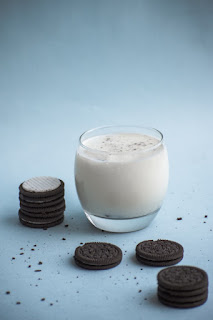Ever since the National Biscuit Company launched what would become its most famous and popular product in 1912, materials scientists had been consumed by a "burning" question. Is it possible to twist the halves of an Oreo cookie so that its rich creme filling shears in half and sticks to each delicious chocolate wafer of the sandwich cookie when it is pulled apart?
It took eleven decades, but a team of MIT scientists finally cracked the problem wide open in 2022. They discovered the answer to that question is no, it is not possible. They discovered that because the creme filling of an Oreo sandwich cookie is "mushy", it is "very difficult to get it to stick to both sides when you twist one apart."
Or as MIT's Crystal Owens describes it, "what actually happens is the creme almost always comes of one side."
What made this incredible scientific discovery possible was the scientists invention of a device that could reliably apply a twisting force evenly on the halves of an Oreo cookie to measure how much torsion was applied before it split apart. Their specialized, unpatented innovation is called "The Oreometer". The following short video illustrates both what it is and how it works:
The device is intriguing in part because it doesn't require any electricity or utilize any electronic gages to either operate or measure the amount of torque applied to the Oreo cookie being twisted apart.
Because of their use of this invention in their research, the MIT researchers identified why the creme filling of an Oreo doesn't shear in half when the cookie is twisted, but instead tends to stick to just one of the chocolate wafers that make up the sandwich cookie.
Through a series of experiments with a laboratory rheometer used to hold whole Oreo cookies, we determined that creme distribution upon cookie separation by torsional rotation is not a function of rate of rotation, creme “stuf” (i.e., filling height H) level, or flavor, but was mostly determined by the preexisting level of adhesion between the cookie creme and each wafer. In most cases, creme delaminated from the wafer with a preferential orientation with respect to the package within any one box, allowing prediction of failure direction with 80% accuracy. Despite the consistent failure mode, there was some amount of cookie-to-cookie and box-to-box variation in failure stress and strain. Apparent reflow of creme due to unknown causes had the most significant effect in altering failure type, allowing for improved creme–wafer bonds and subsequent cohesive failure of the creme, splitting nearly evenly between the two wafers. Failure mechanics further allowed us to classify the creme texture as “mushy.”
In less scientific language, the mushy creme filling is less likely to stick to the chocolate wafer being twisted than it is to either split or shear within itself because of the applied torque. This characteristic is why twisting an Oreo sandwich cookie most often results in most of the creme filling remaining attached to one of the chocolate wafers but not the other when they are twisted apart.
That, as they say in science, is a result! Not to mention a finding made possible by a special purpose invention developed to support the rheologists' research.
From the Inventions in Everything Archives
Amazingly, the IIE team has previous featured another Oreo-related innovation, one also designed to perform a very specific task in which the parts of the sandwich cookie are separated from each other:
References
Crystal E. Owens, Max R. Fan, A. Johhn Hart, and Gareth H. McKinley. On Oreology, the fracture and flow of "milk's favorite cookie". Physics of Fluids 34, 043107 (2022). DOI: 10.1063/5.0085362.
Image credit: Photo by Suveer Bhat on Unsplash.
Labels: food, technology
Welcome to the blogosphere's toolchest! Here, unlike other blogs dedicated to analyzing current events, we create easy-to-use, simple tools to do the math related to them so you can get in on the action too! If you would like to learn more about these tools, or if you would like to contribute ideas to develop for this blog, please e-mail us at:
ironman at politicalcalculations
Thanks in advance!
Closing values for previous trading day.
This site is primarily powered by:
CSS Validation
RSS Site Feed
JavaScript
The tools on this site are built using JavaScript. If you would like to learn more, one of the best free resources on the web is available at W3Schools.com.
